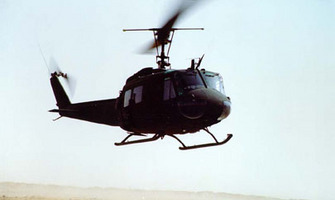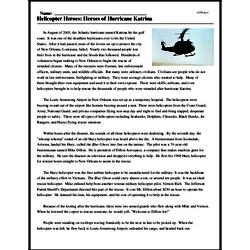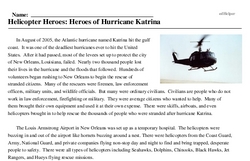Helicopter Heroes: Heroes of Hurricane Katrina
In August of 2005, the Atlantic hurricane named Katrina hit the gulf coast. It was one of the deadliest hurricanes ever to hit the United States. After it had passed, most of the levees set up to protect the city of New Orleans, Louisiana, failed. Nearly two thousand people lost their lives in the hurricane and the floods that followed. Hundreds of volunteers began rushing to New Orleans to begin the rescue of stranded citizens. Many of the rescuers were firemen, law enforcement officers, military units, and wildlife officials. But many were ordinary civilians. Civilians are people who do not work in law enforcement, firefighting or military. They were average citizens who wanted to help. Many of them brought their own equipment and used it at their own expense. There were skiffs, airboats, and even helicopters brought in to help rescue the thousands of people who were stranded after hurricane Katrina.
The Louis Armstrong Airport in New Orleans was set up as a temporary hospital. The helicopters were buzzing in and out of the airport like hornets buzzing around a nest. There were helicopters from the Coast Guard, Army, National Guard, and private companies flying non-stop day and night to find and bring trapped, desperate people to safety. There were all types of helicopters including Seahawks, Dolphins, Chinooks, Black Hawks, Jet Rangers, and Hueys flying rescue missions.
Within hours after the disaster, the sounds of all these helicopters were deafening. By the seventh day, the "whomp-whomp" sound of an old Huey helicopter was heard above the din. A businessman from Scottsdale, Arizona, landed his Huey, called the Blue Ghost, into line on the tarmac. The pilot was a 70-year-old businessman named Mike Dillon. He is president of Dillon Aerospace, a company that makes machine guns for the military. He saw the disaster on television and dropped everything to help. He flew his 1968 Huey helicopter for sixteen hours straight to New Orleans to assist in the rescue.
The Huey helicopter was the first turbine helicopter to be manufactured for the military. It was the backbone of the military effort in Vietnam. The Blue Ghost could carry almost a ton, or around ten people. It was an ideal rescue helicopter. Mike enlisted help from another veteran military helicopter pilot, Vernon Rich. The Jefferson Parish Sheriff's Department directed this part of the rescue. It cost Mr. Dillon about $250 an hour to operate his helicopter. He donated his time, his equipment, and the cost of operating it to help in the rescue.
Because of the looting after the hurricane, there were two armed guards who flew along with Mike and Vernon. When he lowered the copter to rescue someone, he would yell, "Welcome to Dillon Air!"




